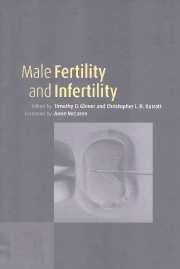Book contents
- Frontmatter
- Contents
- List of contributors
- Foreword by Anne McLaren, FRS
- Preface
- Acknowledgements
- Part 1 Biological perspectives
- Part 2 Implications of the new technologies
- 8 ICSI: the revolution and the portents
- 9 The genetic basis of male infertility
- 10 The treatment of azoospermia with surgery and ICSI
- 11 The challenge of asthenozoospermia
- 12 Molecular techniques for the diagnosis of inherited disorders and male reproductive malfunction
- 13 Gazing into the crystal ball: future diagnosis and management in andrology
- Index
8 - ICSI: the revolution and the portents
from Part 2 - Implications of the new technologies
Published online by Cambridge University Press: 09 August 2009
- Frontmatter
- Contents
- List of contributors
- Foreword by Anne McLaren, FRS
- Preface
- Acknowledgements
- Part 1 Biological perspectives
- Part 2 Implications of the new technologies
- 8 ICSI: the revolution and the portents
- 9 The genetic basis of male infertility
- 10 The treatment of azoospermia with surgery and ICSI
- 11 The challenge of asthenozoospermia
- 12 Molecular techniques for the diagnosis of inherited disorders and male reproductive malfunction
- 13 Gazing into the crystal ball: future diagnosis and management in andrology
- Index
Summary
Introduction
For years, both the understanding and the treatment of male infertility have been disappointing. A specific treatment could be offered only in rare selected cases in which the pathological background was recognized and for which a treatment was available. In an attempt to optimize semen characteristics, the majority of patients suffering from male infertility have therefore been given gonadotrophins, anti-oestrogens, androgens or even antibiotics, without any pathophysiological rationale. Since controlled trials have not been able to demonstrate any significant benefit from such aspecific treatments (O'Donovan et al., 1993), techniques of assisted reproduction, i.e. intra-uterine insemination and in vitro fertilization and embryo transfer (IVE-ET), became more popular in the 1980s.
Results after IVF-ET in patients with male infertility, however, continued to be limited because in vitro fertilization relies on several conditions, among them an adequate number of selected functional spermatozoa and normal gamete interaction. The latter is deficient in many cases involving sperm disorders. In the 1990s, the use of micromanipulation led to hopes of greater success, but the initial techniques of assisted fertilization, i.e. partial zona dissection (PZD) or subzonal insemination (SUZI) failed to increase the success rates in cases with severe male infertility. The most dramatic improvement was achieved only by the introduction of the technique of intracytoplasmic sperm injection (ICSI) (Palermo et al., 1992, Van Steirteghem et al., 1993a, b).
- Type
- Chapter
- Information
- Male Fertility and Infertility , pp. 149 - 161Publisher: Cambridge University PressPrint publication year: 1999



